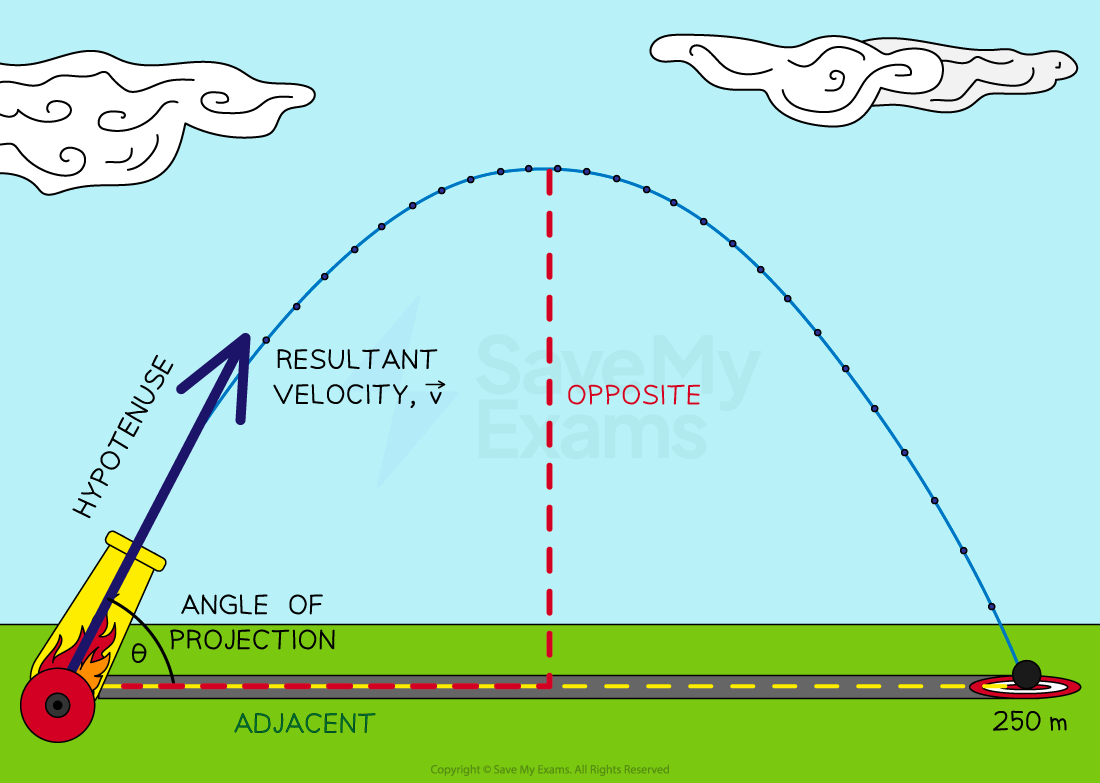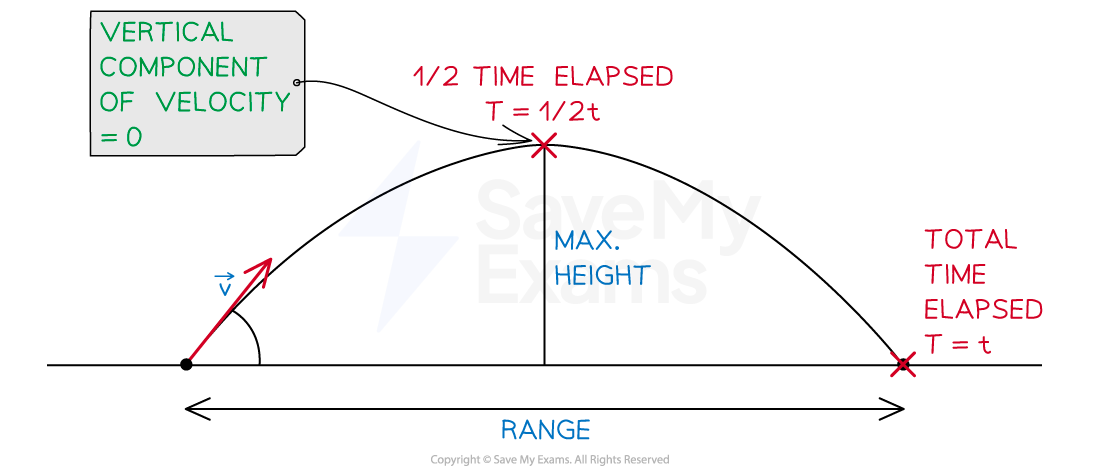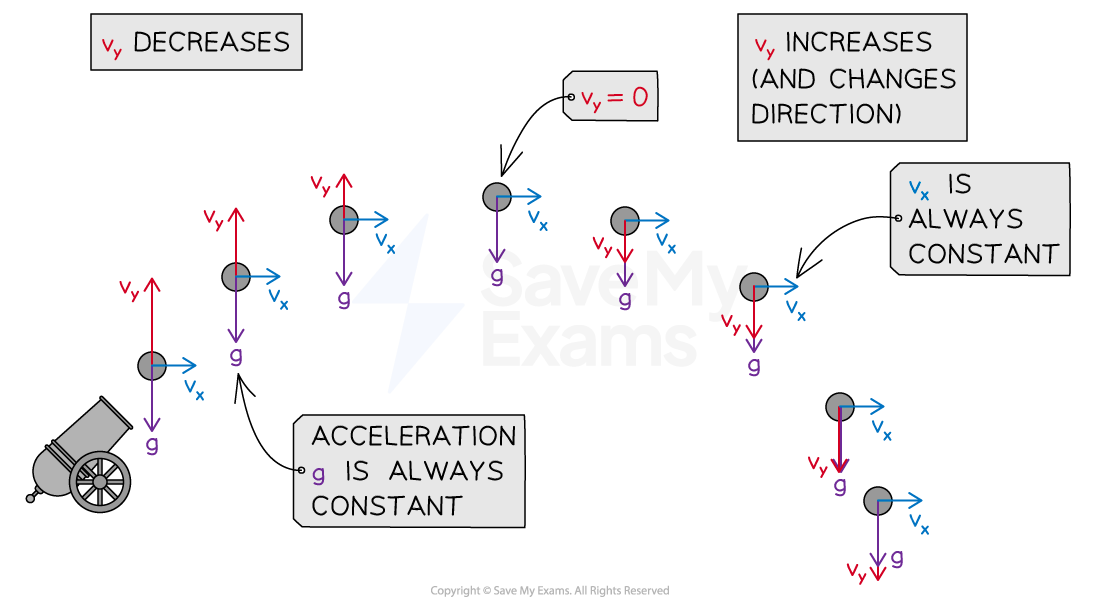Projectile Motion (College Board AP® Physics 1: Algebra-Based): Study Guide
Projectile motion
Projectile motion is a special case of two-dimensional motion
Projectile motion will always have:
zero acceleration in one dimension
constant, nonzero acceleration in the second dimension
A projectile is defined as:
An object moving freely under gravity in a two dimensional plane
Examples of projectiles include:
throwing a ball
jumping off a diving board
hitting a baseball with a bat
Projectiles are usually launched or thrown into the air, at which point the only force acting on the object is the force of weight
It is assumed air resistance is ignored
Therefore, the constant nonzero acceleration in the second dimension is acceleration due to gravity at the Earth's surface,
Calculations involving projectile motion
The vertical and horizontal components of motion are independent of one another
Each plane of motion must be evaluated separately using the kinematic equations
A projectile will have a parabolic trajectory if it is launched at any angle other than directly vertical
The direction of the resultant velocity of a projectile is an angle, θ , to the horizontal
The magnitude of the component velocities can be calculated using trigonometry

Some key terms to know:
Time of flight (total time): how long the projectile is in the air
For typical projectile motion, the time to the maximum height is half of the total time
Maximum height attained: the height at which the projectile is momentarily at rest
This occurs when the vertical velocity component is equal to zero
The projectile is at its maximum height when half of its total time has elapsed
Range: the horizontal displacement of the projectile

For objects in projectile motion:
The horizontal velocity is constant
Therefore, the horizontal acceleration is zero
The vertical velocity changes
The vertical acceleration is constant at
downward

Worked Example
A soccer ball at rest on the ground, is kicked with an initial velocity of at an angle of
relative to the ground.
Considering the two-dimensional motion of the soccer ball, calculate:
(a) the time of flight.
(b) the maximum height attained.
(c) the range.
Answer:
Analyze the scenario
Time of flight is the total time that the ball is in the air
The ball reaches its maximum height when its vertical velocity drops to zero
Maximum height occurs halfway through its time of flight
The range is determined by the horizontal displacement during the time of flight
Part (a) Calculate the time of flight
Step 1: List the known quantities
Taking upward as positive
Magnitude of resultant initial velocity,
Direction of initial velocity,
Acceleration,
Step 2: Consider the y direction
The
component of the initial velocity,
, is given by:
At the apex of the projectile motion, the vertical velocity is momentarily zero as it turns from travelling upwards to downwards
Use this moment as final velocity in the
direction,
Step 3: Apply the correct kinematic equation
To find the time taken to reach the apex, use the equation:
The time taken to reach the apex of motion is half the total time
This is because the motion is symmetrical
Total time of flight is therefore:
Part (b) Calculate the maximum height
Step 1: List the known quantities
Initial vertical velocity,
Final vertical velocity at apex,
Acceleration,
Total time of flight is known, but it is best to use quantities given in the question
Step 2: Apply the correct fundamental equation
To find the displacement at the apex of the trajectory,
, use the following equation and set the initial displacement,
, to zero:
Rearrange for
and substitute known quantities:
Part (c) Calculate the range
Step 1: List the known quantities
Magnitude of resultant initial velocity,
Direction of initial velocity,
Total time of flight,
Step 2: Consider the horizontal direction
In the
direction, no forces act so acceleration is zero
The initial
component of velocity is given by:
The soccer ball continues at this horizontal velocity for the duration of the motion
Step 3: Apply the correct kinematic equation
To find the horizontal range,
, use the equation:
Acceleration is zero because horizontal velocity is always constant
Total time is the same as that of the vertical motion:
Examiner Tips and Tricks
The trick to these calculations is setting the relevant velocities to zero. Practice with these techniques prior to your exam.

Unlock more, it's free!
Did this page help you?